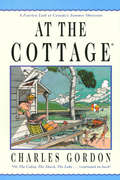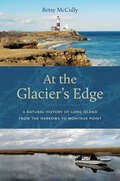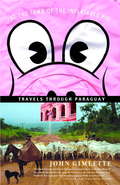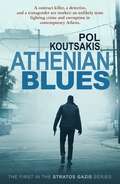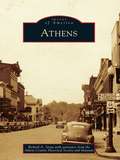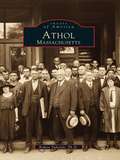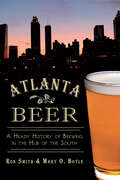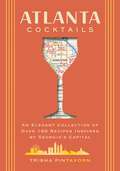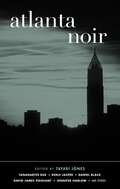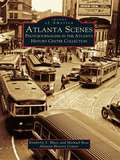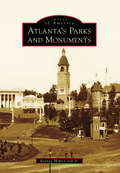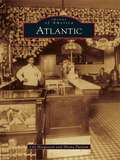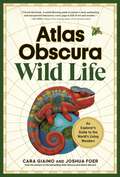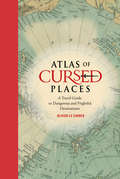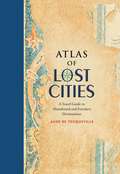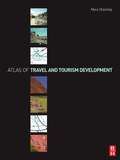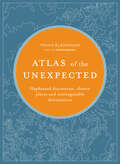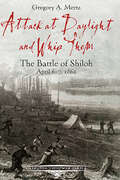- Table View
- List View
At the Cottage
by Charles GordonWhatever you call it, every Canadian summer home needs at least one copy of Charles Gordon's wry, affectionate, and very funny study of our national obsession with that special summer place.From the Hardcover edition.
At the Glacier’s Edge: A Natural History of Long Island from the Narrows to Montauk Point
by Betsy McCullyVast salt marshes, ancient grasslands, lush forests, pristine beaches and dunes, and copious inland waters, all surrounded by a teeming sea. These are probably not the first things you imagine when you think of Long Island, but just beyond its highways and housing developments lies a stunning landscape full of diverse plant and animal life. Combining science writing, environmental history, and first-hand accounts from a longtime resident, At the Glacier’s Edge offers a unique narrative natural history of Long Island. Betsy McCully tells the story of how the island was formed at the end of the last ice age, how its habitats evolved, and how humans in the last few hundred years have radically altered and degraded its landscape. Yet as she personally recounts the habitat losses and species declines she has witnessed over the past few decades, she describes the vital efforts that environmental activists are making to restore and reclaim this land—from replanting salt marshes, to preserving remaining grasslands and forests, to cleaning up the waters. At the Glacier’s Edge provides an in-depth look at the flora, fauna and geology that make Long Island so special.
At the Lightning Field
by Laura RaicovichWalter De Maria's "Lightning Field" is 400 stainless steel poles, positioned 220 feet apart, in the desert of central New Mexico. Over the course of several visits, it becomes, for Raicovich, a site for confounding and revealing perceptions of time, space, duration, and light; how changeable they are, while staying the same.
At the Tomb of the Inflatable Pig
by John GimletteA wildly humorous account of the author's travels across Paraguay-South America's darkly fabled, little-known "island surrounded by land." <P><P>Rarely visited by tourists and barely touched by global village sprawl, Paraguay remains a mystery to outsiders. Think of this small nation and your mind is likely to jump to Nazis, dictators, and soccer. Now, John Gimlette's eye-opening book-equal parts travelogue, history, and unorthodox travel guide-breaches the boundaries of this isolated land," and illuminates a little-understood place and its people. <P><P>It is a wonderfully animated telling of Paraguay's story: of cannibals, Jesuits, and sixteenth-century Anabaptists; of Victorian Australian socialists and talented smugglers; of dictators and their mad mistresses; bloody wars and Utopian settlements; and of lives transplanted from Japan, Britain, Poland, Russia, Germany, Ireland, Korea, and the United States. <P><P>The author travels from the insular cities and towns of the east, along ghostly trails through the countryside, to reach the Gran Chaco of the west: the "green hell" covering almost two-thirds of the country, where 4 percent of the population coexists-more or very-much-less peacefully-with a vast array of exotic wildlife that includes jaguars, prehistoric lungfish, and their more recently evolved distant cousins, the great fighting river fish. Gimlette visits with Mennonites and the indigenas, arms dealers and real-estate tycoons, shopkeepers, government bureaucrats and, of course, Nazis. <P><P>Filled with bizarre incident, fascinating anecdote, and richly evocative detail, At the Tomb of the Inflatable Pig is a brilliant description of a country of eccentricity and contradiction, of beguilingly individualistic men and women, and of unexpected and extraordinary beauty. It is a vivid, often riotous, always fascinating, journey.
Athenian Blues
by Pol KoutsakisStratos hates being called a hitman. He takes care of problems. Permanently. Problems that people pay handsomely to have solved. His clients don’t want to know the details, but Stratos is conscientious. He will only take on a job if his research shows that the targets deserve their fate.In the midst of the Greek economic crisis, Stratos takes on the highest-profile case of his career. The most celebrated lawyer in Greece and his beautiful actress wife both bid for his services, but which one is telling the truth? Helped by his three childhood friends, Drag, a homicide cop, Teri, a high-class transgender sex worker, and Maria, the love of his and Drag's life, he realises that truth is always relative.Especially when shattered loves and broken families are involved.
Athens
by James H.S. McGregorRevered as the birthplace of Western thought and democracy, Athens is much more than an open-air museum filled with crumbling monuments to ancient glory. Athens takes readers on a journey from the classical city-state to today's contemporary capital, revealing a world-famous metropolis that has been resurrected and redefined time and again. Although the Acropolis remains the city's anchor, Athens' vibrant culture extends far beyond the Greek city's antique boundaries. James H. S. McGregor points out how the cityscape preserves signs of the many actors who have crossed its historical stage. Alexander the Great incorporated Athens into his empire, as did the Romans. Byzantine Christians repurposed Greek temples, the Parthenon included, into churches. From the thirteenth to fifteenth centuries, the city's language changed from French to Spanish to Italian, as Crusaders and adventurers from different parts of Western Europe took turns sacking and administering the city. An Islamic Athens took root following the Ottoman conquest of 1456 and remained in place for nearly four hundred years, until Greek patriots finally won independence in a blood-drenched revolution. Since then, Athenians have endured many hardships, from Nazi occupation and military coups to famine and economic crisis. Yet, as McGregor shows, the history of Athens is closer to a heroic epic than a Greek tragedy. Richly supplemented with maps and illustrations, Athens paints a portrait of one of the world's great cities, designed for travelers as well as armchair students of urban history.
Athens and Limestone County
by Kelly KazekAthens and Limestone County were founded in 1818, the year before Alabama became a state, making Athens one of its oldest cities. The quaint, picturesque downtown square in Athens, the county seat, is the heart of the community. Athens and Limestone County are studies in the ongoing tug-of-war between tradition and progress. Athens is traditionally a railroad and cotton town--once ranking among the state's largest cotton producers--but since the aerospace boom of the 1960s, it has increasingly entered the orbit of the technology center of nearby Huntsville, home of the U.S. Space and Rocket Center and Redstone Arsenal. These days, Athens is home to many manufacturing firms, and local civic groups are focused on revitalizing downtown and bringing tourists to Limestone County.
Athens: Excavations And Studies Conducted By The University Of Pennsylvania Museum And The British School At Athens (Images of America)
by Richard A. Straw Athens County Historical Society and MuseumIn the late 1700s, a group of men, largely from Massachusetts, came into the foothills of the Appalachian Mountains and settled a village in southeastern Ohio alongside the Hocking River. Calling it Athens to honor their belief in the primacy of education and culture in one's life, they set in motion a history that continues to inform and enliven life within this community today. Ohio University, the first public institution of higher learning in the Northwest Territory, was founded here in 1804. Athens has served as a business, service, cultural, and educational meeting place for over 200 years. As a result, Athens is a culturally diverse community of professors, plumbers, lawyers, craftsmen, restaurateurs, students, musicians, artists, and business owners, and it is heir to a historic past. This collection of fascinating photographs of people, places, homes, businesses, churches, and important events comes from the vast archives of the Athens County Historical Society and Museum. The images open the past and provide an informative glimpse into an earlier period of life in this unique community.
Athol, Massachusettes
by Robert TuholskiNestled among the hills of Massachusetts, 70 mileswest of Boston, Athol lies on the banks of the Millers River. First settled as "Pequoiag" in 1735 and incorporated as Athol in 1762, the evolution of Athol from a sparse, agrarian settlement to a bustling industrial community is a blueprint for the transformation of small-town America. This exciting collection presents a visual history of Athol at the dawn of the twentieth century. Athol, Massachusettsdocuments the changes as the town developed from an agrarian community into a thriving manufacturing center that harnessed Mill Brook and the Millers River to power the early mills. Through photographs, stereo cards, and postcards from a bygone era, this book provides a glimpse of what it was like to live and work in the Athol of long ago. The photographs from years gone by allow both young and old to meander down dirt roads along the stream, and become witness to their celebrations and their recreational retreats at the fairgrounds, Silver Lake, and Brookside Park.
Atlanta Beer: A Heady History of Brewing in the Hub of the South (American Palate Ser.)
by Ron Smith Mary O. Boyle&“Delve[s] into a colorful past . . . Stories of early taverns and saloons, religious zeal, prohibition and the roots of the current craft beer boom.&” —Atlanta Journal Constitution Atlanta is a unique southern city known for its vast diversity and fast-paced lifestyle. Rarely is it associated with a rich beer and brewing culture, but not for a lack of one. From Atlanta&’s first brewery in the 1850s to the city&’s Saloon Row and the parched days of local and national Prohibition, the earliest days of Atlanta&’s beer history are laced with scandal and excitement. Follow the journey of beer through Atlanta&’s development, starting with colonial Georgia and the budding wilderness settlement of Terminus and eventually evolving into the ever-growing metropolis known as Atlanta. Authors Ron Smith and Mary Boyle celebrate the resurgence of craft beer in a town that once burned to the ground. As Atlanta rose from the ashes of the Civil War, so also has artisanal beer made a comeback in this enigmatic but resilient city. &“The brewery sections draw attention to some long-neglected businesses . . . But the chapter on Prohibition may be the most fascinating part of the book.&” —American Breweriana Journal &“A fascinating read for any craft beer lover in the Southeast. The book features chapters on frontier taverns of the area, Atlanta&’s first beer boom, stories of early breweries of the city, the brewpub trend and the rise of current breweries located in Georgia&’s capital.&” —Owen Ogletree&’s Brewtopia Brewsletter
Atlanta Cocktails: An Elegant Collection of Over 100 Recipes Inspired by Georgia’s Capital (City Cocktails)
by Trisha PintavornThis spirited collection brings you 100 exclusive recipes from Atlanta&’s most renowned bars.From the classic Old Fashioned to modern concoctions, these signature recipes embody the unique charm of Southern hospitality. With over 100 recipes and dozens of bartender profiles, you can drink like a local wherever you are. This book is broken down by neighborhood, so you can find the best bars and finest signature creations that Atlanta has to offer. Residents and tourists alike will discover locations and drinks that are sure to satisfy all tastes.Within the gorgeous, die-cut covers, you'll find:More than 100 essential and exciting cocktail recipes, including recipes for bespoke ingredients and other serving suggestionsInterviews with the city&’s trendsetting bartenders and mixologistsBartending tips and techniques from the expertsFood and drink destinations across the cityAnd much more!Get a taste of Atlanta&’s craft cocktail scene without ever leaving your zip code with Atlanta Cocktails.
Atlanta Noir (Akashic Noir #0)
by Tayari JonesThis much-anticipated and long-overdue installment in Akashic’s Noir Series reveals many sides of Atlanta only known to its residents. “Atlanta has its share, maybe more than its share, of prosperity. But wealth is no safeguard against peril . . . Creepy as well as dark, grim in outlook . . . Hints of the supernatural may make these tales . . . appealing to lovers of ghost stories.” —Kirkus Reviews Akashic Books continues its award-winning series of original noir anthologies, launched in 2004 with Brooklyn Noir. Each book comprises all new stories, each one set in a distinct neighborhood or location within the respective city. This much-anticipated and long-overdue installment in Akashic’s Noir Series reveals many sides of Atlanta known only to its residents. Brand-new stories by: Tananarive Due, Kenji Jasper, Tayari Jones, Dallas Hudgens, Jim Grimsley, Brandon Massey, Jennifer Harlow, Sheri Joseph, Alesia Parker, Gillian Royes, Anthony Grooms, John Holman, Daniel Black, and David James Poissant. From the introduction by Tayari Jones: Atlanta itself is a crime scene. After all, Georgia was founded as a de facto penal colony and in 1864, Sherman burned the city to the ground. We might argue about whether the arson was the crime or the response to the crime, but this is indisputable: Atlanta is a city sewn from the ashes and everything that grows here is at once fertilized and corrupted by the past . . . These stories do not necessarily conform to the traditional expectations of noir . . . However, they all share the quality of exposing the rot underneath the scent of magnolia and pine. Noir, in my opinion, is more a question of tone than content. The moral universe of the story is as significant as the physical space. Noir is a realm where the good guys seldom win; perhaps they hardly exist at all. Few bad deeds go unrewarded, and good intentions are not the road to hell, but are hell itself . . . Welcome to Atlanta Noir. Come sit on the veranda, or the terrace of a high-rise condo. Pour yourself a glass of sweet tea, and fortify it with a slug of bourbon. Put your feet up. Enjoy these stories, and watch your back.
Atlanta Scenes: Photojournalism in the Atlanta History Center Collection
by Michael Rose Atlanta History Center Kimberly S. BlassAtlanta, the thriving capital of the New South, has a rich and fascinating history. In Atlanta Scenes, authors Kimberly S. Blass and Michael Rose draw from the works of some of the city's earliest and finest photojournalists--Francis Price, Marion Johnson, Bill Wilson, and Kenneth Rogers--to bring that history to life. Atlanta Scenes documents some of the city's noteworthy events, personalities, and landmarks, many of which will be readily identifiable. The images range from the everyday (baseball games at Ponce de Leon Ballpark, boys on bicycles, and Humane Society dog rescues) to the eventful (the Gone with the Wind premiere, the deadly Winecoff Hotel fire, and the infamous Leo Frank trial). Many scenes reflect the iconography of the Old South, while others provide insight into the harsh realities of twentieth-century life. In this volume, well-crafted, artistic images blend with on-the-spot action shots.
Atlanta's Parks and Monuments
by Rodney Mims Cook Jr.Since the city's beginnings after the War of 1812, Atlanta has had a tradition of building with a regard for becoming a world-class metropolis. Before being burned by Union general William T. Sherman in 1864, the city's appearance was described by noted European architect and urban planner Leon Krier as "looking like London in the 18th century." Atlanta was surrounded by estates and plantations, and many of the plantation builders were influenced by Greek and Roman architecture. The argument of slavery to the contrary, builders saw Greek temples as symbols of democracy and, as a result, embraced Greek and Roman revival architecture as the dominant national style. Great monuments followed in this tradition to the letter in the capital of the South.
Atlantic
by Shiona Putnam Lila HoogeveenThe history of Atlantic is rooted in the story of unrelenting entrepreneur Franklin H. Whitney. His passion inspired a strong and enterprising breed of men who embraced his vision and settled in the lush hills and valleys of Cass County, Iowa, in the decade following the close of the Civil War. The railroad provided the impetus for rapid growth and prosperity, and Whitney's vision of a new city became a reality when his recommendation for a depot site was approved. Within six days, Whitney's agent, Thomas Miller, had built the first house from which Whitney ordered furrows plowed to the railroad grading. Atlantic was thus born. The town grew rapidly, and by 1869 civic and social organizations, churches, newspapers, banks, schools, and businesses were thriving. Atlantic also had its share of shady characters, outlaw gangs, and disasters. The photographs and stories in this book provide a glimpse into the lives of Atlantic's intrepid developers and the city they established in the valley of the Nishnabotna.
Atlantic High: A Celebration
by William F. Buckley Jr.William F. Buckley Jr.'s account of his voyage across the Atlantic Ocean in the sailboat Sealestial, Atlantic High is a work that everywhere evidences Buckley's love for sailing and good companionship. Infused with his inimitable wit and supported by a rich fund of anecdotes and observations, Atlantic High is truly a one-of-a-kind work.
Atlas Obscura, 2nd Edition: An Explorer's Guide to the World's Hidden Wonders (Atlas Obscura)
by Joshua Foer Dylan Thuras Ella Morton Atlas ObscuraThe bestselling book that celebrates wonder all around the world and in our backyards, now in an updated second edition with more than 120 brand-new destinations to explore, new city guides, and a full-color gatefold map.
Atlas Obscura: An Explorer's Guide to the World's Hidden Wonders (Atlas Obscura)
by Joshua Foer Dylan Thuras Ella MortonIt's time to get off the beaten path. Inspiring equal parts wonder and wanderlust, Atlas Obscura celebrates over 700 of the strangest and most curious places in the world. Talk about a bucket list: here are natural wonders—the dazzling glowworm caves in New Zealand, or a baobob tree in South Africa that's so large it has a pub inside where 15 people can drink comfortably. Architectural marvels, including the M.C. Escher-like stepwells in India. Mind-boggling events, like the Baby Jumping Festival in Spain, where men dressed as devils literally vault over rows of squirming infants. Not to mention the Great Stalacpipe Organ in Virginia, Turkmenistan's 40-year hole of fire called the Gates of Hell, a graveyard for decommissioned ships on the coast of Bangladesh, eccentric bone museums in Italy, or a weather-forecasting invention that was powered by leeches, still on display in Devon, England. Created by Joshua Foer, Dylan Thuras and Ella Morton, ATLAS OBSCURA revels in the weird, the unexpected, the overlooked, the hidden and the mysterious. Every page expands our sense of how strange and marvelous the world really is. And with its compelling descriptions, hundreds of photographs, surprising charts, maps for every region of the world, it is a book to enter anywhere, and will be as appealing to the armchair traveler as the die-hard adventurer. Anyone can be a tourist. ATLAS OBSCURA is for the explorer.
Atlas Obscura: An Explorer's Guide to the World's Living Wonders
by Joshua Foer Atlas Obscura Cara GiaimoFrom the bestselling authors of Atlas Obscura and Gastro Obscura comes a nature book like no other—a dazzling, over-the-top collection of the world's most extraordinary wild species that takes you to all seven continents and beyond. It's more than a field guide–it's an adventure. From the curious minds of Atlas Obscura, authors of #1 New York Times bestselling Atlas Obscura and Gastro Obscura, comes an unputdownable celebration of the world's living wonders. Learn how dung beetles navigate by the stars, and trees communicate through their roots. Meet one of the strongest animals in the world: the puny peacock mantis shrimp. Pay your respects to a 44,000 year old shrub, float along flying rivers, and explore a garbage dump overseen by endangered storks. Examine old examples of bird song notation written on sheet music. Also, first person interviews: hear from a honey hunter and his avian partners, a scientist working to find the world's only ocean-dwelling insects, and an offshore radio DJ who is at the heart of the local fishing community. Featuring over 500 extraordinary plants, animals, and natural phenomena, with illustrations and photos on every page, the book takes readers around the globe—from Antarctic deserts to lush jungles, and into the deepest fathoms of the ocean and the hearts of our densest cities. Teeming with detail and wildly entertaining, Wild Life reinvigorates our sense of wonder, awe and amazement about the incredible creatures we share our planet with.
Atlas of Cursed Places: A Travel Guide to Dangerous and Frightful Destinations
by Olivier Le CarrerOliver Le Carrer brings us a fascinating history and armchair journey to the world's most dangerous and frightful places, complete with vintage maps and period illustrations in a handsome volume. This alluring read includes 40 locations that are rife with disaster, chaos, paranormal activity, and death. The locations gathered here include the dangerous Strait of Messina, home of the mythical sea monsters Scylla and Charybdis; the coal town of Jharia, where the ground burns constantly with fire; Kasanka National Park in Zambia, where 8 million migrating bats darken the skies; the Nevada Triangle in the Sierra Nevada mountains, where hundreds of aircraft have disappeared; and Aokigahara Forest near Mount Fuji in Japan, the world's second most popular suicide location following the Golden Gate Bridge.
Atlas of Lost Cities: A Travel Guide to Abandoned and Forsaken Destinations
by Aude De TocquevilleLike humans, cities are mortal. They are born, they thrive, and they eventually die. In Atlas of Lost Cities, Aude de Tocqueville tells the compelling narrative of the rise and fall of such notable places as Pompeii, Teotihuacán, and Angkor. She also details the less well known places, including Centralia, an abandoned Pennsylvania town consumed by unquenchable underground fire; Nova Citas de Kilamba in Angola, where housing, schools, and stores were built for 500,000 people who never came; and Epecuen, a tourist town in Argentina that was swallowed up by water. Beautiful, original artwork shows the location of the lost cities and depicts how they looked when they thrived.
Atlas of Shipwrecks and Fortunes of the Sea (Atlas Series #4)
by Cyril HofsteinThis new title in this bestselling series relates 37 stories of shipwrecks, great discoveries, mysteries, and disappearances still thrilling adventure seekers. From the Atlantic to the Pacific Ocean, from the Baltic Sea to the Caribbean, the Antarctic, and the Indian Ocean; from ancient history to the present day, these short tales cover all aspects of high-seas adventure and feature prominent human incidents and tragic events. Combining tales of adventures and legends, they fuel the imagination of all those captivated by the sea and its sailors. The most-famous stories are part of our maritime heritage, like the legend of the Flying Dutchman, which inspired the ghost ship in Pirates of the Caribbean, or the fire that destroyed the MS Georges Philippar off the coast of Somalia, causing the death of senior reporter Albert Londres, who was then returning from China. Some are based on real historical events, like the sinking of La Belle, which put an end to the conquest of North America by the French, or the historic duel between the CSS Alabama, a Confederate raider, and a Union frigate USS Kearsarge, which moved the American Civil War to the English Channel. Many more have been long forgotten and are ready to come to life again.
Atlas of Travel and Tourism Development: Participatory Research For Community-based Natural Resource Management
by Myra ShackleyFrom travel in the ancient and classical world to the growth of underwater tourism in the Great Barrier Reef and the influence of the Gulf War on regional tourism, the Atlas of Travel and Tourism Development is a new departure from conventional texts, providing a unique overview of the growth of the tourism industry.Divided into three sections, the text looks first at the past, examining the influence of global geography on travel patterns, and provides an overview of the history of travel and tourism. It then moves onto the present, using a regional framework to demonstrate how the physical and historical geography of each area is related to tourism development. The final section provides a forecast of future trends for the next two decades.
Atlas of the Unexpected: Haphazard Discoveries, Chance Places and Unimaginable Destinations (Unexpected Atlases Ser.)
by Travis ElboroughA journey to forty-five unexpected destinations near and far, with quirky histories, beautiful maps, and evocative photography: “First-class armchair travel.” —South China Morning PostA New Statesman Best Book of the YearTake an armchair voyage to places both infamous and unknown that have, often by chance or by haphazard means, been destinations of discovery that shaped our world. Set foot on the aptly named Just Enough Room Island. Chart the royal romance that led shipwrecked lovers to discover the purple rock of Madeira. Learn about the surprising origins of Vaseline. Follow in the footsteps of a stray goat who led its keeper to uncover lost ancient biblical scrolls. These are the world’s most wondrous, improbable, and—most of all—unexpected places, presented by a cultural historian and winner of an Edward Stanford Travel Writing Award.“Elborough writes about a wide range of subjects with originality, learning and charm. Atlas of the Unexpected . . . is seductively beautiful: an inspiring, dream-inducing guide.” —New StatesmanPraise for the Unexpected Atlas series“Engrossing.” —The Observer“Understatedly expressive.” —The New York Times“A delightful compendium.” —The Daily Telegraph
Attack at Daylight and Whip Them: The Battle of Shiloh, April 6–7, 1862 (Emerging Civil War Series)
by Gregory A. MertzThis Civil War history and guide presents an engaging chronicle of the Battle of Shiloh with information and insights about the Tennessee battlefield. The Union Army of the Tennessee, commanded by Major General Ulysses S. Grant, had gathered on the banks of its namesake river at a spot called Pittsburg Landing, ready to strike deep into the heart of Tennessee Confederates, commanded by General Albert Sidney Johnston. Johnston&’s troops were reeling from setbacks earlier in the year and had decided to reverse their fortunes by taking the fight to the Federals. Johnston planned to attack them at daylight and drive them into the river. As a brutal fight ensued, Grant gathered reinforcements and planned a counteroffensive. On the morning of April 7, he initiated his own bloody daybreak attack. The horrors of this two-day battle exceeded anything America had ever known in its history. Historian Greg Mertz grew up on the Shiloh battlefield, hiking its trails and exploring its fields. Attack at Daylight and Whip Them taps into five decades of intimate familiarity with a battle that rewrote America&’s notions of war.
